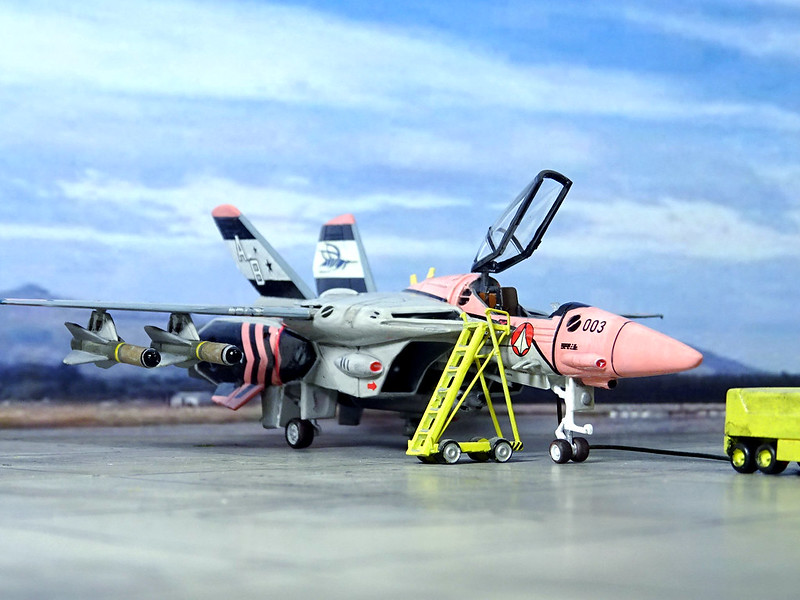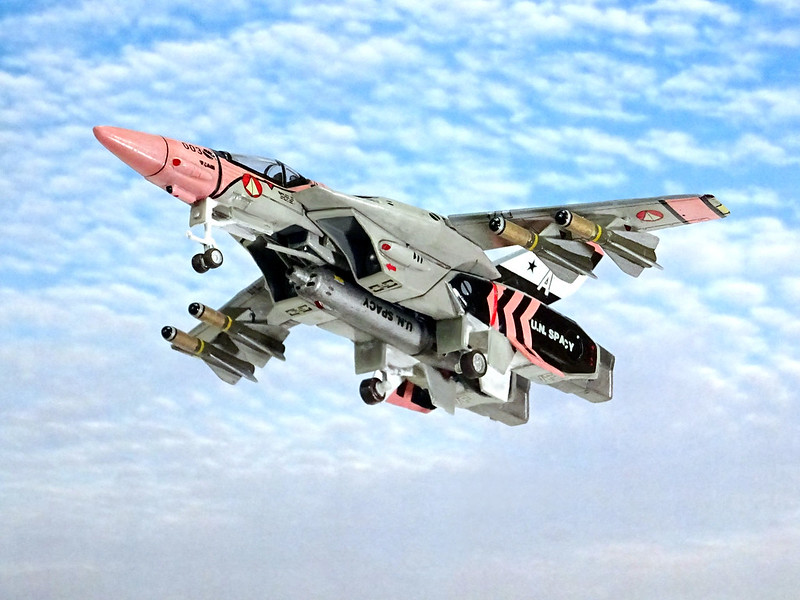


Some background:The VF-1 was developed by Stonewell/Bellcom/Shinnakasu for the U.N. Spacy by using alien Overtechnology obtained from the SDF-1 Macross alien spaceship. Its production was preceded by an aerodynamic proving version of its airframe, the VF-X. Unlike all later VF vehicles, the VF-X was strictly a jet aircraft, built to demonstrate that a jet fighter with the features necessary to convert to Battroid mode was aerodynamically feasible. After the VF-X's testing was finished, an advanced concept atmospheric-only prototype, the VF-0 Phoenix, was flight-tested from 2005 to 2007 and briefly served as an active-duty fighter from 2007 to the VF-1's rollout in late 2008, while the bugs were being worked out of the full-up VF-1 prototype (VF-X-1).
The space-capable VF-1's combat debut was on February 7, 2009, during the Battle of South Ataria Island - the first battle of Space War I - and remained the mainstay fighter of the U.N. Spacy for the entire conflict. Introduced in 2008, the VF-1 would be out of frontline service just five years later, though.



The VF-1 proved to be an extremely capable craft, successfully combating a variety of Zentraedi mecha even in most sorties which saw UN Spacy forces significantly outnumbered. The versatility of the Valkyrie design enabled the variable fighter to act as both large-scale infantry and as air/space superiority fighter. The signature skills of U.N. Spacy ace pilot Maximilian Jenius exemplified the effectiveness of the variable systems as he near-constantly transformed the Valkyrie in battle to seize advantages of each mode as combat conditions changed from moment to moment.
The basic VF-1 was deployed in four minor variants (designated A, D, J, and S) and its success was increased by continued development of various enhancements including the GBP-1S "Armored" Valkyrie, FAST Pack "Super" Valkyrie and the additional RÖ-X2 heavy cannon pack weapon system for the VF-1S for additional firepower.
The FAST Pack system was designed to enhance the VF-1 Valkyrie variable fighter, and the initial V1.0 came in the form of conformal pallets that could be attached to the fighter’s leg flanks for additional fuel – primarily for Long Range Interdiction tasks in atmospheric environment. Later FAST Packs were designed for space operations.




After the end of Space War I, the VF-1 continued to be manufactured both in the Sol system and throughout the UNG space colonies. Although the VF-1 would be replaced in 2020 as the primary Variable Fighter of the U.N. Spacy by the more capable, but also much bigger, VF-4 Lightning III, a long service record and continued production after the war proved the lasting worth of the design.
The versatile aircraft also underwent constant upgrade programs. For instance, about a third of all VF-1 Valkyries were upgraded with Infrared Search and Track (IRST) systems from 2016 onwards, placed in a streamlined fairing on the upper side of the nose, just in front of the cockpit. This system allowed for long-range search and track modes, freeing the pilot from the need to give away his position with active radar emissions, and it could also be used for target illumination and guiding precision weapons.
Many Valkyries also received improved radar warning systems, with receivers, depending on the systems, mounted on the wingtips, on the fins and/or on the LERXs. Improved ECR measures were also mounted on some machines, typically in conformal fairings on the flanks of the legs/engine pods.
The VF-1 was without doubt the most recognizable variable fighter of Space War I and was seen as a vibrant symbol of the U.N. Spacy even into the first year of the New Era 0001 in 2013. At the end of 2015 the final rollout of the VF-1 was celebrated at a special ceremony, commemorating this most famous of variable fighters. The VF-1 Valkryie was built from 2006 to 2013 with a total production of 5,459 VF-1 variable fighters with several variants (VF-1A = 5,093, VF-1D = 85, VF-1J = 49, VF-1S = 30, VF-1G = 12, VE-1 = 122, VT-1 = 68).



However, the fighter was frequently updated, leading to several “re-built” variants, and remained active in many second line units and continued to show its worthiness years later, e. g. through Milia Jenius who would use her old VF-1 fighter in defense of the colonization fleet - 35 years after the type's service introduction!
This VF-1A was assigned to SVF-51 “Yellow Jackets”, and based onboard the UES Constellation platform in Lower Earth Orbit (LEO). The Constellation was tasked during the First Space War with the close defense of Moon Base Apollo, but also undertook atmospheric missions.
This particular fighter sported the squadron’s typical striped high visibility markings over a standard gloss light gray base on wings and legs, but unlike normal machines of this unit, with deep yellow and black markings, was, together with two sister ships, assigned to the unit’s staff flight. Each of these VF-1’s carried the unit markings and additional flight leader decoration on the noses in non-regular colors: turquoise on “001”, violet on “002” and pink on “003” – giving them one of the most distinctive and attractive paint schemes during the Space War.
General characteristics:
All-environment variable fighter and tactical combat Battroid, used by U.N. Spacy, U.N. Navy, U.N. Space Air Force
Accommodation:Pilot only in Marty & Beck Mk-7 zero/zero ejection seat
Dimensions:Fighter Mode:
Length 14.23 meters
Wingspan 14.78 meters (at 20° minimum sweep)
Height 3.84 meters
Battroid Mode:
Height 12.68 meters
Width 7.3 meters
Length 4.0 meters
Empty weight: 13.25 metric tons;
Standard T-O mass: 18.5 metric tons;
MTOW: 37.0 metric tons
Power Plant:2x Shinnakasu Heavy Industry/P&W/Roice FF-2001 thermonuclear reaction turbine engines, output 650 MW each, rated at 11,500 kg in standard or in overboost (225.63 kN x 2)
4x Shinnakasu Heavy Industry NBS-1 high-thrust vernier thrusters (1 x counter reverse vernier thruster nozzle mounted on the side of each leg nacelle/air intake, 1 x wing thruster roll control system on each wingtip);
18x P&W LHP04 low-thrust vernier thrusters beneath multipurpose hook/handles
Performance:Battroid Mode: maximum walking speed 160 km/h
Fighter Mode: at 10,000 m Mach 2.71; at 30,000+ m Mach 3.87
g limit: in space +7
Thrust-to-weight ratio: empty 3.47; standard T-O 2.49; maximum T-O 1.24
Design Features:3-mode variable transformation; variable geometry wing; vertical take-off and landing; control-configurable vehicle; single-axis thrust vectoring; three "magic hand" manipulators for maintenance use; retractable canopy shield for Battroid mode and atmospheric reentry; option of GBP-1S system, atmospheric-escape booster, or FAST Pack system
Transformation:Standard time from Fighter to Battroid (automated): under 5 sec.
Min. time from Fighter to Battroid (manual): 0.9 sec.
Armament:1x internal Mauler RÖV-20 anti-aircraft laser cannon, firing 6,000 pulses per minute
1x Howard GU-11 55 mm three-barrel Gatling gun pod with 200 RPG, fired at 1,200 rds/min
4x underwing hard points for a wide variety of ordnance, including
12x AMM-1 hybrid guided multipurpose missiles (3/point), or
12x MK-82 LDGB conventional bombs (3/point), or
6x RMS-1 large anti-spaceship reaction missiles (2/outboard point, 1/inboard point), or
4x UUM-7 micro-missile pods (1/point) each carrying 15 x Bifors HMM-01 micro-missiles, or a combination of above load-outs and other guided and unguided ordnance




Ein kleines und schnelles Zwischenprojekt, das in nur wenigen Tagen realisiert wurde - die meiste Zeit verging, während darauf gewartet wurde, dass die glänzenden Humbrol-Farben richtig trockneten…

Es gibt sicherlich bessere VF-1-Modelle in 1:100 als die Vintage-ARII-Kits, aber ich liebe sie einfach, denn sie sind klein, einfach und leicht zu modifizieren. Tatsächlich wurde der Anstrich durch ein Profil aus einer kanonischen Quelle inspiriert - und anstelle des Original-Gelb habe ich darais einfach eine Maschine des Führungsstabes gemacht, mit individuellen Farben. In der Nähe der Design-Benchmark zu bleiben war allerdings eine ziemliche Herausforderung, hat aber gut geklappt, obwohl ich gehofft hatte, dass das Pink etwas mehr hervorstechen würde.
Hier das Original (verlinkt von
http://mechajournal.com/2016/03/vf-1-valkyrie-color-plate-gallery/):

